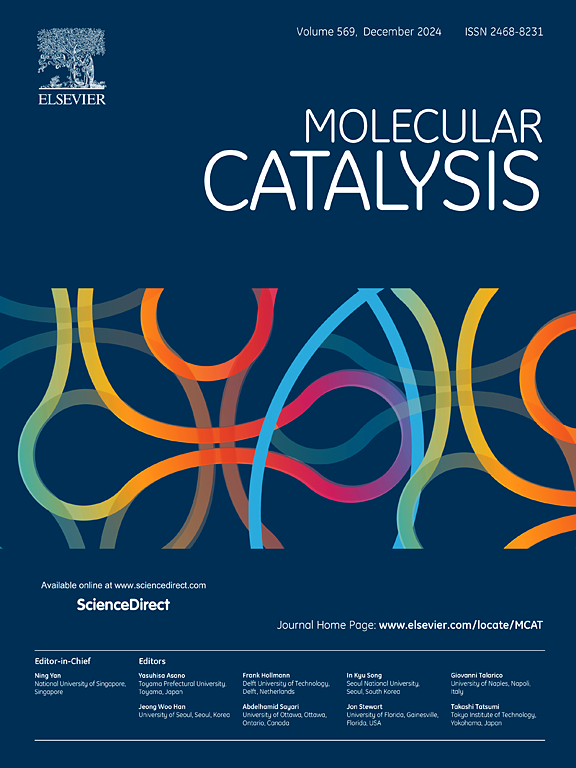Mechanistic study on the conversion of primary alcohols and butadiene into branched ketones using a rhodium catalyst
IF 3.9
2区 化学
Q2 CHEMISTRY, PHYSICAL
引用次数: 0
Abstract
The direct formation of saturated branched ketones from primary alcohols and butadiene in the absence of premetalated intermediates or other hydrogen sources is a mechanistically intriguing transformation. Catalyzed by a rhodium(I) catalyst (Rh(COD)2BArF4/PPh3) under basic conditions, this reaction proceeds with moderate to high experimental yields. Applying density functional theory, we investigate the mechanism of the conversion of 3-methoxybenzyl alcohol and butadiene into (branched) isobutyl ketone. This reaction involves four key steps: (i) oxidation of the alcohol to the corresponding aldehyde, with the generation of an Rh(I) hydride complex as an active catalyst, (ii) hydrogenation of butadiene to form an allyl–Rh(I) complex, (iii) carbonyl addition from the allylic carbon, forming an Rh(I) alkoxide intermediate, and (iv) an intramolecular hydrogen-transfer processes to generate the desired ketone product. The rate-determining states correspond to the carbonyl addition, involving both the intermediate and transition states, with an energy barrier of +30.4 kcal/mol. We found that two PPh3 ligands are coordinated to the Rh center throughout the reaction. Therefore, carbonyl addition to the linear ketone is inhibited by steric hindrance around the metal center. Stereoisomerism among intermediates has a negligible effect on the reaction energetics and does not affect the configuration of the final product, which is released in an enolate form. Calculated positions of the transferred hydrogens align with the experimental deuterium labeling results, highlighting a hydrogen (auto)transfer mechanism in the transformation of primary alcohols to branched ketones.
铑催化剂催化伯醇和丁二烯转化为支链酮的机理研究
伯醇和丁二烯在没有预金属中间体或其他氢源的情况下直接形成饱和支化酮,这在机理上是一个有趣的转变。在铑(I)催化剂(Rh(COD)2BArF4/PPh3)的催化下,该反应在基本条件下进行,实验产率中高。应用密度泛函理论,研究了3-甲氧基苄基醇和丁二烯转化成(支化)异丁基酮的机理。该反应包括四个关键步骤:(i)将醇氧化为相应的醛,生成Rh(i)氢化物配合物作为活性催化剂;(ii)丁二烯加氢形成烯丙基- Rh(i)配合物;(iii)烯丙基碳的羰基加成,形成Rh(i)醇氧化物中间体;(iv)分子内氢转移过程生成所需的酮产物。羰基加成反应的决定速率态包括中间态和过渡态,能垒为+30.4 kcal/mol。我们发现两个PPh3配体在整个反应过程中与Rh中心配合。因此,羰基对线性酮的加成受到金属中心周围空间位阻的抑制。中间体间的立体异构对反应能量的影响可以忽略不计,也不影响最终产物的构型,最终产物以烯醇酯形式释放。计算的转移氢的位置与实验氘标记结果一致,突出了伯醇转化为支链酮的氢(自动)转移机制。
本文章由计算机程序翻译,如有差异,请以英文原文为准。
求助全文
约1分钟内获得全文
求助全文
来源期刊

Molecular Catalysis
Chemical Engineering-Process Chemistry and Technology
CiteScore
6.90
自引率
10.90%
发文量
700
审稿时长
40 days
期刊介绍:
Molecular Catalysis publishes full papers that are original, rigorous, and scholarly contributions examining the molecular and atomic aspects of catalytic activation and reaction mechanisms. The fields covered are:
Heterogeneous catalysis including immobilized molecular catalysts
Homogeneous catalysis including organocatalysis, organometallic catalysis and biocatalysis
Photo- and electrochemistry
Theoretical aspects of catalysis analyzed by computational methods
 求助内容:
求助内容: 应助结果提醒方式:
应助结果提醒方式:


